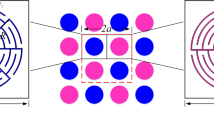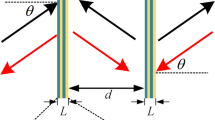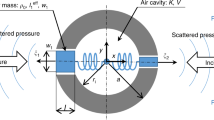Abstract
Metamaterials, man-made composite media structured on a scale much smaller than a wavelength, offer surprising possibilities for engineering the propagation of waves1,2,3,4,5,6. One of the most interesting of these is the ability to achieve superlensing—that is, to focus or image beyond the diffraction limit7. This originates from the left-handed behaviour—the property of refracting waves negatively—that is typical of negative index metamaterials8,9,10. Yet reaching this goal requires the design of ‘double negative’ metamaterials, which act simultaneously on the permittivity and permeability in electromagnetics11,12, or on the density and compressibility in acoustics; this generally implies the use of two different kinds of building blocks13,14 or specific particles presenting multiple overlapping resonances15,16,17. Such a requirement limits the applicability of double negative metamaterials, and has, for example, hampered any demonstration of subwavelength focusing using left-handed acoustic metamaterials18. Here we show that these strict conditions can be largely relaxed by relying on media that consist of only one type of single resonant unit cell. Specifically, we show with a simple yet general semi-analytical model that judiciously breaking the symmetry of a single negative metamaterial is sufficient to turn it into a double negative one. We then demonstrate that this occurs solely because of multiple scattering of waves off the metamaterial resonant elements, a phenomenon often disregarded in these media owing to their subwavelength patterning. We apply our approach to acoustics and verify through numerical simulations that it allows the realization of negative index acoustic metamaterials based on Helmholtz resonators only. Finally, we demonstrate the operation of a negative index acoustic superlens, achieving subwavelength focusing and imaging with spot width and resolution 7 and 3.5 times better than the diffraction limit, respectively. Our findings have profound implications for the physics of metamaterials, highlighting the role of their subwavelength crystalline structure, and hence entering the realm of metamaterial crystals. This widens the scope of possibilities for designing composite media with novel properties in a much simpler way than has been possible so far.
This is a preview of subscription content, access via your institution
Access options
Subscribe to this journal
Receive 51 print issues and online access
$199.00 per year
only $3.90 per issue
Buy this article
- Purchase on Springer Link
- Instant access to full article PDF
Prices may be subject to local taxes which are calculated during checkout




Similar content being viewed by others
References
Pendry, J., Holden, A., Stewart, W. & Youngs, I. Extremely low frequency plasmons in metallic mesostructures. Phys. Rev. Lett. 76, 4773–4776 (1996)
Pendry, J. B., Holden, J., Robbins, D. J. & Stewart, W. J. Magnetism from conductors and enhanced nonlinear phenomena. IEEE Trans. Microw. Theory Tech. 47, 2075–2084 (1999)
Liu, Z. et al. Locally resonant sonic materials. Science 289, 1734–1736 (2000)
Deymier, P. A. Acoustic Metamaterials and Phononic Crystals (Springer, 2013)
Engheta, N. & Ziolkowski, R. Metamaterials: Physics and Engineering Explorations (Wiley & Sons, 2006)
Craster, R. V. & Guenneau, S. Acoustic Metamaterials: Negative Refraction, Imaging, Lensing and Cloaking (Springer, 2012)
Pendry, J. B. Negative refraction makes a perfect lens. Phys. Rev. Lett. 85, 3966–3969 (2000)
Lee, S. H., Park, C. M., Seo, Y. M., Wang, Z. G. & Kim, C. K. Composite acoustic medium with simultaneously negative density and modulus. Phys. Rev. Lett. 104, 054301 (2010)
Liang, Z., Feng, T., Lok, S., Liu, F. & Ng, K. Space-coiling metamaterials with double negativity and conical dispersion. Sci. Rep. 3, 1–6 (2013)
Xie, Y., Popa, B. I., Zigoneanu, L. & Cummer, S. a. Measurement of a broadband negative index with space-coiling acoustic metamaterials. Phys. Rev. Lett. 110, 175501 (2013)
Veselago, V. G. The electrodynamics of substances with simultaneous negative values of ε and μ. Phys. Uspekhi 10, 509–514 (1968)
Smith, D. R., Padilla, W. J., Vier, D. C., Nemat-Nasser, S. C. & Schultz, S. Composite medium with simultaneously negative permeability and permittivity. Phys. Rev. Lett. 84, 4184–4187 (2000)
Shelby, R. A., Smith, D. R. & Schultz, S. Experimental verification of a negative index of refraction. Science 292, 77–79 (2001)
Guenneau, S., Movchan, A., Pétursson, G. & Anantha Ramakrishna, S. Acoustic metamaterials for sound focusing and confinement. New J. Phys. 9, 399 (2007)
Li, J. & Chan, C. T. Double-negative acoustic metamaterial. Phys. Rev. E 70, 055602 (2004)
Brunet, T. et al. Soft 3D acoustic metamaterial with negative index. Nature Mater. 14, 384–388 (2015)
Zhu, R., Liu, X. N., Hu, G. K., Sun, C. T. & Huang, G. L. Negative refraction of elastic waves at the deep-subwavelength scale in a single-phase metamaterial. Nature Commun. 5, 5510 (2014)
Zhang, S., Yin, L. & Fang, N. Focusing ultrasound with an acoustic metamaterial network. Phys. Rev. Lett. 102, 194301 (2009)
Kanté, B. et al. Symmetry breaking and optical negative index of closed nanorings. Nature Commun. 3, 1180 (2012)
Christ, A., Martin, O. J. F., Ekinci, Y., Gippius, N. A. & Tikhodeev, S. G. Symmetry breaking in a plasmonic metamaterial at optical wavelength. Nano Lett. 8, 2171–2175 (2008)
Sukhovich, A. et al. Experimental and theoretical evidence for subwavelength imaging in phononic crystals. Phys. Rev. Lett. 102, 154301 (2009)
Notomi, M. Theory of light propagation in strongly modulated photonic crystals: refractionlike behavior in the vicinity of the photonic band gap. Phys. Rev. B 62, 10696–10705 (2000)
Yariv, A. & Yeh, P. Optical Waves in Crystals (Wiley, 1984)
Lemoult, F., Kaina, N., Fink, M. & Lerosey, G. Wave propagation control at the deep subwavelength scale in metamaterials. Nature Phys. 9, 55–60 (2013)
Fleischhauer, M. & Marangos, J. P. Electromagnetically induced transparency: optics in coherent media. Rev. Mod. Phys. 77, 633–673 (2005)
Papasimakis, N., Fedotov, V., Zheludev, N. & Prosvirnin, S. Metamaterial analog of electromagnetically induced transparency. Phys. Rev. Lett. 101, 253903 (2008)
Kaina, N., Lemoult, F., Fink, M. & Lerosey, G. Ultra small mode volume defect cavities in spatially ordered and disordered metamaterials. Appl. Phys. Lett. 102, 144104 (2013)
Leonhardt, U. Optical conformal mapping. Science 312, 1777–1780 (2006)
Pendry, J. B., Schurig, D. & Smith, D. R. Controlling electromagnetic fields. Science 312, 1780–1782 (2006)
Lemoult, F., Fink, M. & Lerosey, G. Acoustic resonators for far-field control of sound on a subwavelength scale. Phys. Rev. Lett. 107, 064301 (2011)
de Vries, P., Van Coevorden, D. & Lagendijk, A. Point scatterers for classical waves. Rev. Mod. Phys. 70, 447–466 (1998)
Fokin, V., Ambati, M., Sun, C. & Zhang, X. Method for retrieving effective properties of locally resonant acoustic metamaterials. Phys. Rev. B 76, 144302 (2007)
Belov, P. A., Simovski, C. R. & Ikonen, P. Canalization of subwavelength images by electromagnetic crystals. Phys. Rev. B 71, 193105 (2005)
Zhu, J. et al. A holey-structured metamaterial for acoustic deep-subwavelength imaging. Nature Phys. 7, 52–55 (2010)
Acknowledgements
We thank A. Lagendijk for sharing his knowledge of multiple scattering techniques. This work was supported by LABEX WIFI (Laboratory of Excellence within the French Program “Investments for the Future”) grants ANR-10-LABX-24 and ANR-10-IDEX-0001-02 PSL*, and by Agence Nationale de la Recherche grant ANR-13-JS09-0001-01. N.K. acknowledges funding from the French “Direction Générale de l’Armement”.
Author information
Authors and Affiliations
Contributions
G.L. conceived the original idea. G.L. and F.L supervised the project. N.K. and F.L. performed the analytical and numerical work. N.K., F.L. and G.L. performed the experiments, analysed the data, and wrote the manuscript. All authors discussed the results and commented on the manuscript.
Corresponding author
Ethics declarations
Competing interests
The authors declare no competing financial interests.
Extended data figures and tables
Extended Data Figure 1 Effective parameters for metamaterials made from resonant point scatterers.
a, Parameters for the single negative medium made of a periodic arrangement of identical point scatterers. b, c, Parameters for the bi-periodic medium (b) and the bi-disperse medium (c), showing the double negativity for each medium. f, Frequency; f0, resonant frequency; see Methods for definitions of variables shown in the keys.
Extended Data Figure 2 Effective parameters for the simulated soda-can metamaterials extracted from the transmission and reflection of a single unit cell.
a–h, Speed of sound (a, e), impedance (b, f), compressibility (c, g) and modulus (d, h) for the triangular (left column) and the honeycomb (right column) arrangements. Thick lines, with loss; thin lines, without loss; blue lines, real part; green lines, imaginary part.
Extended Data Figure 4 Simulated Gaussian beam incident on an infinite slab showing negative refraction at a frequency of 417.5 Hz.
a–d, Simulations for incident angles of 15° (a), 30° (b), 45° (c) and 60° (d); for each angle, data are shown for a lossless slab made of soda cans (left) or of negative effective medium (right). The frequency corresponds to 417.5 Hz, for which the effective index of refraction is −3. Red lines delimit the slab interfaces while white arrows evidence the direction of the incident, reflected and refracted beams.
Extended Data Figure 5 Simulated Gaussian beam incident on an infinite slab showing negative refraction at a frequency of 418.5 Hz.
As Extended Data Fig. 4 but for 418.5 Hz, and an effective index of refraction of −2.4.
Extended Data Figure 6 Simulated Gaussian beam incident on an infinite slab showing negative refraction at a frequency of 419.5 Hz.
As Extended Data Fig. 4 but for 419.5 Hz, and an effective index of refraction of −1.5.
Extended Data Figure 7 Renormalized maps of the measured acoustic pressure intensity for three different frequencies within the negative index of refraction band.
a, f = 417 Hz; b, f = 427 Hz; and c, f = 445 Hz. For each frequency the ray tracing is superimposed (red). The red dashed lines correspond to the slab's interfaces; the white dashed lines highlight the focus depth.
Extended Data Figure 8 Longitudinal profiles of the focus for varying frequencies.
Bottom panel: profiles of the field within the lens (red shading), in its near field (yellow shading) and its far field (green shading) for different frequencies within the negative band (colour key). Top panel: tracked position of the foci in the previously described regions for the same frequencies in the negative band (colour key).
Extended Data Figure 9 Effect of the phase shift between the two sources on the intensity measured on the focal plane.
a, Map of the intensity of the field in the focal plane along the normalized axis y/λ0 (colour coded, key at right) as a function of the phase shift between the sources. b, Profiles of the normalized real part of the field (Re(P)) along the normalized axis y/λ0 for varying phase shifts (colour key) between the two sources.
Rights and permissions
About this article
Cite this article
Kaina, N., Lemoult, F., Fink, M. et al. Negative refractive index and acoustic superlens from multiple scattering in single negative metamaterials. Nature 525, 77–81 (2015). https://doi.org/10.1038/nature14678
Received:
Accepted:
Published:
Issue Date:
DOI: https://doi.org/10.1038/nature14678
This article is cited by
-
Acoustic resonances in non-Hermitian open systems
Nature Reviews Physics (2023)
-
Cubic-symmetry acoustic metamaterials with roton-like dispersion relations
Acta Mechanica Sinica (2023)
-
Wave propagation in elastic metamaterials with nonlinear local resonators
Acta Mechanica (2023)
-
3D printing metamaterials for highly efficient electromagnetic wave absorption
Science China Materials (2023)
-
Broadband Low-Frequency Acoustic Energy Harvesting Amplified by Sonic Crystal Metamaterial with Double Defects
Journal of Vibration Engineering & Technologies (2023)
Comments
By submitting a comment you agree to abide by our Terms and Community Guidelines. If you find something abusive or that does not comply with our terms or guidelines please flag it as inappropriate.



